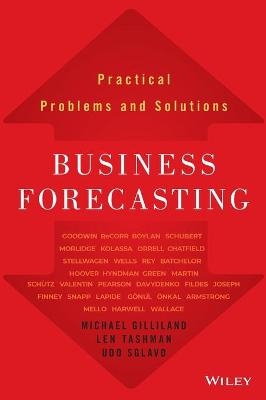
Business Forecasting
John Wiley & Sons Inc (Verlag)
978-1-119-22456-3 (ISBN)
A comprehensive collection of the field's most provocative, influential new work Business Forecasting compiles some of the field's important and influential literature into a single, comprehensive reference for forecast modeling and process improvement. It is packed with provocative ideas from forecasting researchers and practitioners, on topics including accuracy metrics, benchmarking, modeling of problem data, and overcoming dysfunctional behaviors. Its coverage includes often-overlooked issues at the forefront of research, such as uncertainty, randomness, and forecastability, as well as emerging areas like data mining for forecasting.
The articles present critical analysis of current practices and consideration of new ideas. With a mix of formal, rigorous pieces and brief introductory chapters, the book provides practitioners with a comprehensive examination of the current state of the business forecasting field.
Forecasting performance is ultimately limited by the 'forecastability' of the data. Yet failing to recognize this, many organizations continue to squander resources pursuing unachievable levels of accuracy. This book provides a wealth of ideas for improving all aspects of the process, including the avoidance of wasted efforts that fail to improve (or even harm) forecast accuracy.
Analyzes the most prominent issues in business forecasting
Investigates emerging approaches and new methods of analysis
Combines forecasts to improve accuracy
Utilizes Forecast Value Added to identify process inefficiency
The business environment is evolving, and forecasting methods must evolve alongside it. This compilation delivers an array of new tools and research that can enable more efficient processes and more accurate results. Business Forecasting provides an expert's-eye view of the field's latest developments to help you achieve your desired business outcomes.
MICHAEL GILLILAND is Marketing Manager for SAS forecasting software, editor of the Forecasting Practice section of Foresight: The International Journal of AppliedForecasting, and author of The Business Forecasting Deal. He has published articles in Supply Chain Management Review, Journal of Business Forecasting, Analytics, Supply Chain Forecasting Digest, APICS Magazine, Swiss Analytics Magazine, and Foresight. Mike holds a BA in Philosophy from Michigan State University, and Master's degrees in Philosophy and Mathematical Sciences from Johns Hopkins University. Follow his blog, The Business Forecasting Deal, at blogs.sas.com/content/forecasting. LEN TASHMAN is the founding editor of Foresight: The International Journal of Applied Forecasting, now in its 10th year of publication. He serves on the Board of Directors of the International Institute of Forecasters and is organizer and chair of the Forecasting in Practice Track at the annual International Symposium on Forecasting. Len is an emeritus professor of business administration at the University of Vermont and Director of the Center for Business Forecasting. UDO SGLAVO is Senior Director of Predictive Modeling R&D at SAS Institute. His team develops industry-leading and award-winning software for data mining, machine learning, and large scale automatic forecasting. He has published articles in Analytics, and is a contributor to The Business Forecasting Deal blog. Udo has served on the practitioner advisory board of Foresight, and holds a diploma in mathematics from University of Applied Sciences, Darmstadt, Germany.
Foreword xv
Preface xix
Chapter 1 Fundamental Considerations in Business Forecasting 1
1.1 Getting Real about Uncertainty (Paul Goodwin) 3
1.2 What Demand Planners Can Learn from the Stock Market (Charles K. Re Corr) 9
1.3 Toward a More Precise Defi nition of Forecastability (John Boylan) 14
1.4 Forecastability: A New Method for Benchmarking and Driving Improvement (Sean Schubert) 22
1.5 Forecast Errors and Their Avoidability (Steve Morlidge) 36
1.6 The Perils of Benchmarking (Michael Gilliland) 46
1.7 Can We Obtain Valid Benchmarks from Published Surveys of Forecast Accuracy? (Stephan Kolassa) 48
1.8 Defi ning “Demand” for Demand Forecasting (Michael Gilliland) 60
1.9 Using Forecasting to Steer the Business: Six Principles (Steve Morlidge) 67
1.10 The Beauty of Forecasting (David Orrell) 76
Chapter 2 Methods of Statistical Forecasting 81
2.1 Confessions of a Pragmatic Forecaster (Chris Chatfi eld) 82
2.2 New Evidence on the Value of Combining Forecasts (Paul Goodwin) 92
2.3 How to Forecast Data Containing Outliers (Eric Stellwagen) 95
2.4 Selecting Your Statistical Forecasting Level (Eric Stellwagen) 98
2.5 When Is a Flat-line Forecast Appropriate? (Eric Stellwagen) 102
2.6 Forecasting by Time Compression (Udo Sglavo) 104
2.7 Data Mining for Forecasting: An Introduction (Chip Wells and Tim Rey) 112
2.8 Process and Methods for Data Mining for Forecasting (Chip Wells and Tim Rey) 120
2.9 Worst-Case Scenarios in Forecasting: How Bad Can Things Get? (Roy Batchelor) 126
2.10 Good Patterns, Bad Patterns (Roy Batchelor) 135
Chapter 3 Forecasting Performance Evaluation and Reporting 143
3.1 Dos and Don’ts of Forecast Accuracy Measurement: A Tutorial (Len Tashman) 144
3.2 How to Track Forecast Accuracy to Guide Forecast Process Improvement (Jim Hoover) 160
3.3 A “Softer” Approach to the Measurement of Forecast Accuracy (John Boylan) 170
3.4 Measuring Forecast Accuracy (Rob Hyndman) 177
3.5 Should We Defi ne Forecast Error as e = F − A or e = A − F? (Kesten Green and Len Tashman) 184
3.6 Percentage Error: What Denominator? (Kesten Green and Len Tashman) 188
3.7 Percentage Errors Can Ruin Your Day (Stephan Kolassa and Roland Martin) 195
3.8 Another Look at Forecast-Accuracy Metrics for Intermittent Demand (Rob Hyndman) 204
3.9 Advantages of the MAD/Mean Ratio over the MAPE (Stephan Kolassa and Wolfgang Schütz) 211
3.10 Use Scaled Errors Instead of Percentage Errors in Forecast Evaluations (Lauge Valentin) 217
3.11 An Expanded Prediction-Realization Diagram for Assessing Forecast Errors (Roy Pearson) 228
3.12 Forecast Error Measures: Critical Review and Practical Recommendations (Andrey Davydenko and Robert Fildes) 238
3.13 Measuring the Quality of Intermittent Demand Forecasts: It’s Worse than We’ve Thought! (Steve Morlidge) 250
3.14 Managing Forecasts by Exception (Eric Stellwagen) 259
3.15 Using Process Behavior Charts to Improve Forecasting and Decision Making (Martin Joseph and Alec Finney) 262
3.16 Can Your Forecast Beat the Naïve Forecast? (Shaun Snapp) 276
Chapter 4 Process and Politics of Business Forecasting 281
4.1 FVA: A Reality Check on Forecasting Practices (Michael Gilliland) 282
4.2 Where Should the Forecasting Function Reside? (Larry Lapide) 288
4.3 Setting Forecasting Performance Objectives (Michael Gilliland) 294
4.4 Using Relative Error Metrics to Improve Forecast Quality in the Supply Chain (Steve Morlidge) 297
4.5 Why Should I Trust Your Forecasts? (M. Sinan Gönül, Dilek Önkal, and Paul Goodwin) 309
4.6 High on Complexity, Low on Evidence: Are Advanced Forecasting Methods Always as Good as They Seem? (Paul Goodwin) 315
4.7 Should the Forecasting Process Eliminate Face-to-Face Meetings? (J. Scott Armstrong) 319
4.8 The Impact of Sales Forecast Game Playing on Supply Chains (John Mello) 327
4.9 Role of the Sales Force in Forecasting (Michael Gilliland) 340
4.10 Good and Bad Judgment in Forecasting: Lessons from Four Companies (Robert Fildes and Paul Goodwin) 349
4.11 Worst Practices in New Product Forecasting (Michael Gilliland) 358
4.12 Sales and Operations Planning in the Retail Industry (Jack Harwell) 363
4.13 Sales and Operations Planning: Where Is It Going? (Tom Wallace) 372
About the Editors 381
Index 383
| Erscheinungsdatum | 29.02.2016 |
|---|---|
| Reihe/Serie | SAS Institute Inc |
| Verlagsort | New York |
| Sprache | englisch |
| Maße | 185 x 257 mm |
| Gewicht | 975 g |
| Themenwelt | Wirtschaft ► Betriebswirtschaft / Management ► Unternehmensführung / Management |
| Wirtschaft ► Volkswirtschaftslehre ► Ökonometrie | |
| ISBN-10 | 1-119-22456-X / 111922456X |
| ISBN-13 | 978-1-119-22456-3 / 9781119224563 |
| Zustand | Neuware |
| Haben Sie eine Frage zum Produkt? |
aus dem Bereich


